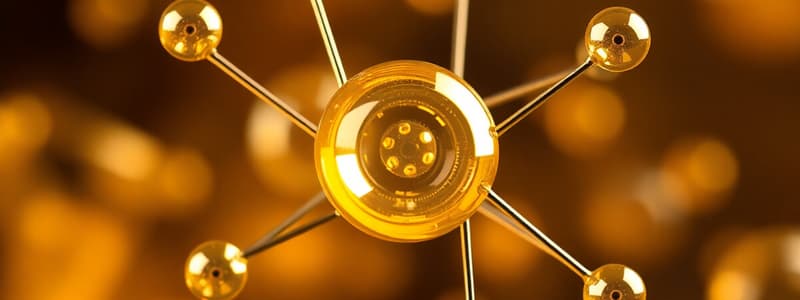Podcast
Questions and Answers
What specifically distinguishes isotopes of an element from each other?
What specifically distinguishes isotopes of an element from each other?
- Different numbers of protons
- Different numbers of electrons
- Different numbers of neutrons (correct)
- Different atomic weights
Which isotope of carbon is used in carbon dating due to its radioactive properties?
Which isotope of carbon is used in carbon dating due to its radioactive properties?
- Carbon 15
- Carbon 13
- Carbon 12
- Carbon 14 (correct)
What total contribution do neutrons and protons make to the atomic weight of an atom?
What total contribution do neutrons and protons make to the atomic weight of an atom?
- They essentially double the atomic weight of the atom.
- They do not contribute significantly to atomic weight.
- They only contribute to half of the atomic weight.
- They are approximately equal to the atomic weight of an atom. (correct)
How is one mole of a substance defined in relation to Avogadro's number?
How is one mole of a substance defined in relation to Avogadro's number?
What is the primary reason living organisms are composed of a small selection of elements?
What is the primary reason living organisms are composed of a small selection of elements?
What is the approximate diameter of an individual carbon atom?
What is the approximate diameter of an individual carbon atom?
In terms of mass, how does one proton or neutron compare in weight to common measurements?
In terms of mass, how does one proton or neutron compare in weight to common measurements?
Which of the following statements about atomic weight is true?
Which of the following statements about atomic weight is true?
What determines the atomic number of an element?
What determines the atomic number of an element?
What role do electrons play in an atom?
What role do electrons play in an atom?
Which statement correctly describes neutrons?
Which statement correctly describes neutrons?
Why do elements have distinct chemical properties?
Why do elements have distinct chemical properties?
How does the structure of an atom contribute to its neutrality?
How does the structure of an atom contribute to its neutrality?
What is the fundamental significance of the arrangement of electrons in an atom?
What is the fundamental significance of the arrangement of electrons in an atom?
Which of the following best describes an atom of hydrogen?
Which of the following best describes an atom of hydrogen?
What primarily holds the electrons in orbit around the nucleus?
What primarily holds the electrons in orbit around the nucleus?
Flashcards are hidden until you start studying
Study Notes
Atoms
- Matter is made of elements, substances that cannot be broken down further by chemical means.
- The smallest unit of an element that retains its chemical properties is an atom.
- Atoms are composed of a central nucleus surrounded by a cloud of negatively charged electrons.
- The nucleus contains protons (positively charged) and neutrons (no charge).
- The number of protons determines the atomic number, which defines the element.
- The number of electrons equals the number of protons, ensuring electrical neutrality.
- The electrons determine the chemical behavior of an atom.
Isotopes
- Isotopes are atoms of the same element with the same number of protons but different numbers of neutrons.
- Different isotopes have the same chemical properties but different physical properties.
- Carbon 12 (6 protons, 6 neutrons) is the most common isotope of carbon.
- Carbon 14 (6 protons, 8 neutrons) is a radioactive isotope used in carbon dating.
Atomic Weight
- Atomic weight is the mass of an atom relative to a hydrogen atom.
- It is determined by the number of protons and neutrons since electrons have negligible mass.
- The atomic weight of carbon 12 is 12, while carbon 14 has an atomic weight of 14.
- Atomic mass is often expressed in daltons, where one dalton is approximately the mass of a hydrogen atom.
Size of Atoms
- Atoms are incredibly small, with a carbon atom measuring roughly 0.2 nm in diameter.
- A single gram of hydrogen contains 6 × 10^23 atoms, also known as Avogadro's number.
Moles and Molar Solutions
- A mole of a substance contains 6 × 10^23 molecules.
- The mass of one mole of a substance in grams is equal to its molecular weight.
Essential Elements of Life
- There are 92 naturally occurring elements.
- Living organisms primarily consist of four elements: carbon (C), hydrogen (H), nitrogen (N), and oxygen (O).
- These four elements account for 96.5% of an organism's body mass.
Studying That Suits You
Use AI to generate personalized quizzes and flashcards to suit your learning preferences.




